Sir Sydney Waterlow, 1st Baronet facts for kids
Sir Sydney Hedley Waterlow (born November 1, 1822 – died August 3, 1906) was a kind British man who helped many people. He was also a Liberal Party politician. He is best known for giving Waterlow Park to the public. He called it "a garden for the gardenless," meaning a green space for people who didn't have their own gardens.
Contents
About Sir Sydney Waterlow
Sir Sydney Waterlow was born in Finsbury, near the City of London. He grew up in Mile End. He went to St Saviour's Grammar School. After school, he learned to be a stationer and printer. He worked for his family's company, Waterlow and Sons. This was a very large printing company that employed over 2,000 people. Later, he also worked in finance and became a director at the Union Bank of London.
Helping His Community
Sir Sydney was very active in public life. In 1857, he became a councillor. He even helped set up telegraph links between police stations. In 1863, he became an alderman. This is when he started many of his projects to help others.
He was the leader of a group called The Improved Industrial Dwellings Company. This company built affordable homes for people, like the Leopold Buildings. He also supported many other charities.
Important Roles
In 1866, he was a Sheriff of the City of London. From 1872 to 1873, he served as the Lord Mayor of London. This is a very important role in the city. While he was Mayor, he helped start the Metropolitan Hospital Sunday Fund. This fund helped hospitals get money.
He was made a knight in 1867. This meant he could use "Sir" before his name. In 1873, he was given an even higher honor, becoming a Baronet. This title could be passed down in his family.
Time in Parliament
Sir Sydney also became a Member of Parliament (MP). He represented Dumfriesshire from 1868 to 1869. He then represented Maidstone (1874–1880) and Gravesend (1880–1885).
His Generous Gifts
In 1872, Sir Sydney gave Lauderdale House to St Bartholomew's Hospital. This house was used as a place for sick people to recover. Nurses, who were trained by Florence Nightingale, helped care for the patients there.
In 1889, he gave the land around Lauderdale House to the London County Council. This land became Waterlow Park, which is still a beautiful public park today. His own house, Fairseat, which was next to the park, later became part of Channing School.
In 1902, Sir Sydney was given another special honor, becoming a Knight Commander of the Royal Victorian Order.
Sir Sydney's Family
Sir Sydney had a large family. His fourth son, David Sydney Waterlow, also became a Liberal MP for Islington North. His nephew, Ernest Albert Waterlow, was a famous artist. His daughter, Ruth Waterlow, worked to improve education and help women.
Sir Sydney's Legacy
Sir Sydney Waterlow passed away in 1906 at the age of 83. He died at his estate called Trosley Towers. His son, Philip, inherited his title and the estate.
After Sir Philip died in 1931, the estate was sold. Some of the houses were bought by the people who lived in them. Trosley Towers and the surrounding woodlands were sold in 1935. The main house, Trosley Towers, was later taken down in 1936. A smaller house, Hamilton Lodge, was built there instead.
During World War II in 1942, the army took over the area. Hamilton Lodge became the headquarters for an army group. Later, the Trosley Towers Estate was bought by Kent County Council. They turned it into Trosley Country Park, which is now a lovely place for people to visit and enjoy nature.


